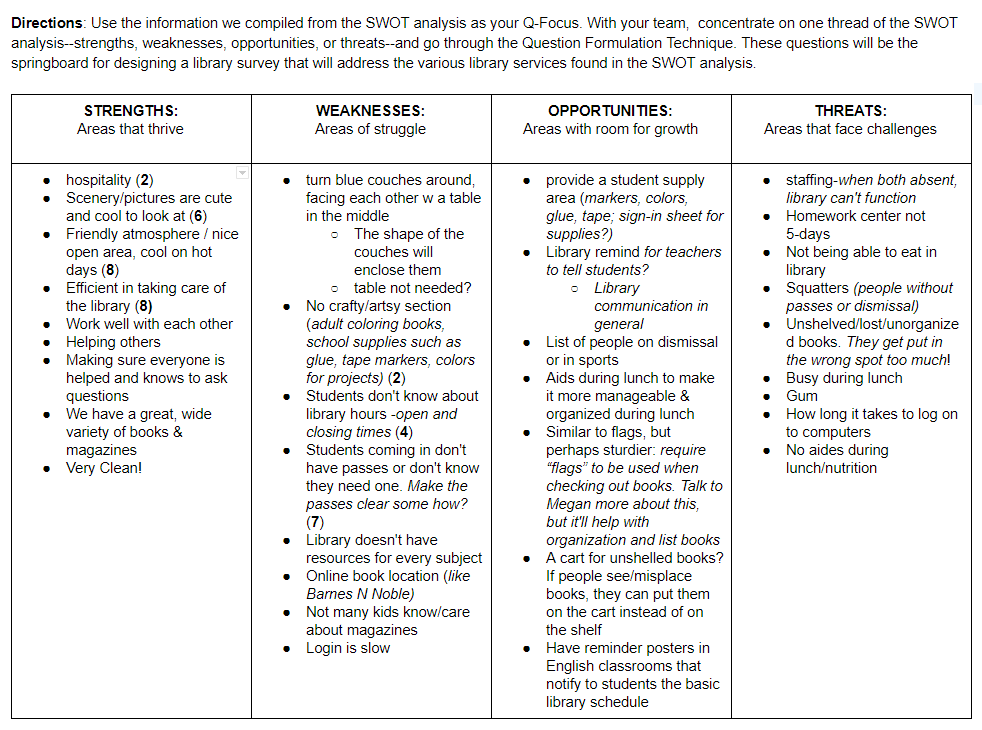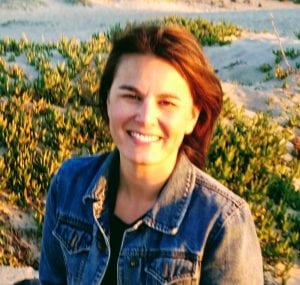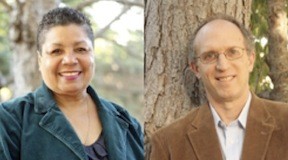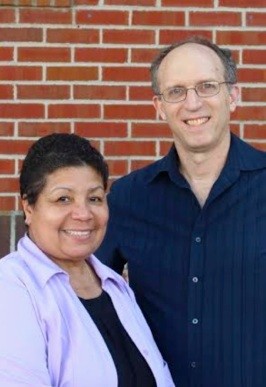by Jennifer Brickey
As a teacher-librarian, part of my responsibility is to support classroom instruction and pedagogy. In my initial musings of how to apply the Question Formulation Technique (QFT) in a library setting, I saw it as a means to involve myself in the question development portion of the research process. After taking RQI’s online course hosted by the Harvard Graduate School of Education, “Teaching Students to Ask Their Own Questions: Best Practices in the Question Formulation Technique,” I noticed that I had limited my application of the QFT only to my immediate setting. I realize now that the QFT has more flexibility. Through watching the instructional videos and reading my cohort’s posts on discussion boards throughout the module, I learned the importance and value of remixing the QFT to keep students engaged with questioning and to open up fresh opportunities for questions to emerge even in informal, unexpected moments. When I say “remixing,” I’m referring to how the QFT can be differentiated according to audience, groupings, purpose, and learning goal.
Since the end of the online module, I’ve been experimenting exploring 4 “remixes” to best serve the teachers and students I work with:
1)The QFT for Professional Development–Sharing the QFT with coworkers serves two important goals: 1) To encourage the faculty to ask questions in order to improve campus culture and instruction and 2) To model the strategy so that teachers can apply it in their own classrooms. As the educators, we serve as models for the students from how we speak and dress to how we carry ourselves in relation to the expectations we set for students. If we expect students to ask questions in the classroom, then teachers should also be willing to pose questions in their professional learning contexts such as staff, department and board meetings. Teachers easily direct questions to students, but often hesitate to ask questions of their colleagues or superiors. I have found that the QFT helps teachers make meaning of new protocols, programs, or other new systems introduced to a school. Additionally, when introducing the QFT as a classroom inquiry strategy with teachers as the students, the teachers feel the power of the discussion and metacognition elements the QFT encompasses. As my site, Oxnard High School (OHS), enters a Western Association of Schools and Colleges (WASC) accreditation year, I would like to try a QFT addressing the major areas of competency–organization, curriculum, instruction, assessment & accountability, and school culture–that WASC requires schools to address. Teachers using questioning is not only part of instruction, but also part of the staff culture.
2)The QFT, Individually: Once students (or staff) have familiarity with the QFT process, they can tackle the QFT on their own. Ideally, after students gain plenty of practice, students will naturally create, evaluate, and prioritize questions on their own.
This school year, I worked with a group of 10th grade students who, as 9th graders, experienced the QFT at least five times. One teacher in the Harvard online course had mentioned he assigned a QFT for homework. When I heard this, I thought, “Of course–this makes total sense!” The sophomore teacher and I decided to give this individualized approach a shot. Students used their “weakest” set of research notes on Othello as their QFocus. I projected the QFT rules and they began creating questions, individually. This really forced them to evaluate their own research and identify any gaps. The sophomores went through all steps of the QFT, including converting questions and prioritizing questions, individually. Upon completion of prioritizing their questions, students gathered with their original, research groups and shared their priority questions and justifications. Running the QFT in this individualized manner, allowed for the quieter students–the introverts–to focus without fear of feeling judged by the group. Many expressed how they felt they could concentrate more, while others missed having more discussion. I love how the QFT teaches the instructor about how his/her students learn.
Students were able to see gaps in their research and many students found that they knew more than they realized. Feedback from the students included:
- “QFT has taught me that I am an observation learner. I see a lot of details. It has also taught me that I can make solid connections on the fly.”
- “QFT taught me that when researching a topic I should start with questions for myself so it can be easier to find what I’m looking for.”
- “I learned that I actually understand the material more than I think I do. Also, I took more and effective notes this time compared to last time.”
- “The QFT helped me find the most important questions that I need to include the answer to in my upcoming presentation. It taught me that all questions are acceptable no matter if it’s vague and hard to answer (there is not only 1 correct answer for this type of Q). I feel like the questions help me see if my research is on topic and can answer the basic questions.”
3) Even More Choice and Voice: A trait of the QFT, in and of itself, is that it encourages students to express themselves by identifying their personal curiosities regarding a topic. Throughout the Harvard course, this trait became even more apparent, especially when student reflections revealed students’ newfound confidence in learning and asking questions.
To capitalize on the confidence effect of the QFT, I wanted my Library Science students to exercise choice and voice through the QFT in order to gain input on library services. In Library Science, a college-prep elective for upperclassmen, students assist with the overall operation of the library (customer service and shelving), practice information literacy and critical thinking skills, and help with library advocacy and marketing. The Library Science students first conducted a SWOT analysis, an assessment of the OHS Library’s strengths, weaknesses, opportunities, and threats. The SWOT analysis then became their QFocus. In an effort to provide more choice and voice, I modified the QFocus so that students could choose to direct their attention to an area of the SWOT analysis that interested them most. They each chose one of the following QFoci: one aspect of the SWOT analysis; converting weaknesses to strengths; turning threats into opportunities; or looking at weaknesses, opportunities, and threats.

A collaborative SWOT Analysis between six periods of library science
Giving personal choice not only allowed students to focus on an element of the SWOT analysis that spoke to him/her, but also generated a helpful range of questions that touched on multiple aspects of the SWOT analysis. I was surprised to see that each of my classes went in very different directions. For example, one group focused heavily on advertising and raised questions about how the library communicates events and services. Another group focused on the patrons and how they do not follow library policies. From there, this same group asked questions about library policies and how they could be modified. Students expressed that they learned more about what the library does and they want to make sure students know about all the services the library has to offer. Other reflection highlights include:
- “The QFT makes us feel open to new improvement and growth in the library. With room to grow, we believe that the we can use our strengths to help the opportunities in the future.”
- “The QFT process helped me connect with my peers in a way I don’t normally do.”
- “The QFT made me feel like there is a lot to learn from other people’s opinions and reasoning. Working with others is better than working with yourself alone.”
- “This made me feel like I need to start taking better notes since this gave me more ideas.”
4) Playing with Pacing: Depending on time, teaching and learning objectives, and the needs of the particular group a teacher is working with, breaking the QFT into various segments allows for a teacher to tailor the QFT and address areas of the strategy that may need more focus. In the online course, I learned that it’s okay to adjust the pace of the QFT. There’s freedom in the process to slow down to account for areas that may require a more detailed explanation or more thorough practice or speed up by condensing steps depending on your objectives and students’ familiarity.
I recently tried condensing the QFT with a group of 9th graders who were giving presentations on social justice issues that they had researched. Rather than having students take notes during the presentations, I asked students to write down questions. I went over the QFT rules and projected them. After each presentation, students posed their questions to the presenting group and the group responded. By having students record their questions during the presentation, students processed information deeply, at their own pace, listened attentively for what they were curious about, and were held accountable for their participation. It was very exciting to watch the students learn from each other. Any question that couldn’t be answered by the group, I, along with the classroom teacher, did our best to satisfy the students’ curiosity. Or, we encouraged more research!
Because of our objectives for this specific lesson (to have students listen actively, quickly produce a few authentic questions about each social justice topic, and engage in rich discussion with students responsible for teaching each topic all in one library period), we decided that categorizing questions as open or closed and strategizing on next steps to take with their questions, wasn’t essential to this particular lesson. Although we didn’t complete the whole QFT, students still completed a reflection regarding their preference to taking notes or asking questions. Here’s what students said:
- “I felt like I learned more because I could ask the group what I was wondering.”
- “Writing questions is better because I was able to understand more.”
- “I wish we got to ask questions more often. I felt smarter.”
Conclusion
With any teaching strategy, a teacher must make it his/her own, to find a way to make the strategy seamless and meaningful for their students. The online module really helped me discover new approaches and applications of the QFT. When you remix the QFT, you can use the QFT or questions more often, and keep the process fresh for the students. I find that remixing the QFT also highlights the importance of pre-determining how you might use the questions students produce and opens up some new possible applications. If you understand the process and if you understand how to remix it, you can tailor your design of the QFT effectively for a specific application of students’ questions. As I move forward in my QFT practice, I hope to communicate more with the classroom teacher(s) to determine the application of the questions so that both teachers and students can see their questions put to good use.
The Harvard course gave me the courage to experiment with remixing the QFT so that I may broaden my reach beyond the library setting. It’s important to me to honor what students want to know, not just what they know. Experimenting with the QFT and finding new applications and contexts for student questions also stemmed from a larger realization about honoring questioning by not limiting it to a time constraint (ie. one class period) Through remixing the QFT, you affirm that questioning should not be limited to a specific time frame because, ultimately, students should be questioning throughout their lives.

Jennifer Brickey is the Teacher-Librarian at Oxnard High School. Eight years prior to transitioning to the library position, Jennifer taught a range of English courses at OHS including remedial reading and honors. Since beginning her teaching career, Jennifer has earned a Master’s Degree in Education from Pepperdine University and a Master’s in Library and Information Science from San Jose State University. She prides herself as an educational leader on campus who strives to improve her craft through exploration and application of new teaching strategies and methods. She also regularly designs and facilitates professional development workshops at her school and district. As a South Coast Writing Project Fellow (2011) and an educator rooted in the power of the written word, Jennifer commits herself to the advocacy of literacy, inquiry, and the literary arts. Jennifer has transformed the OHS Library into a cultural hub for the school where students pursue their passions, interests, and curiosities. Find Jennifer on Twitter @Mrs.Brickey or @OHSLibuzzy.




Speak Your Mind